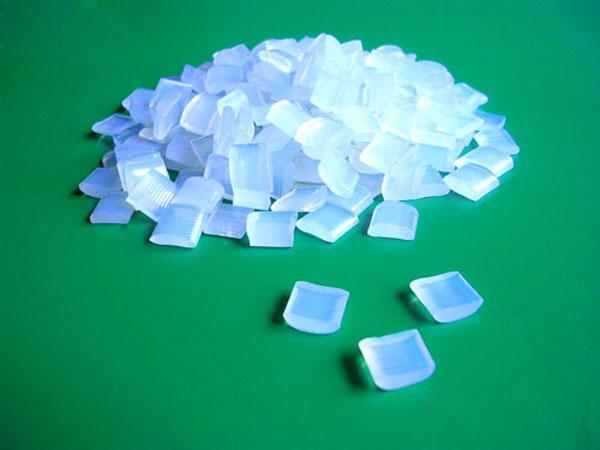Simply put, EVA hot melt adhesive is a solid meltable polymer that does not require solvents and does not contain moisture. It is solid at room temperature and melts when heated to a certain temperature. It becomes a flowable and viscous liquid adhesive. After melting, the colloid of EVA hot melt adhesive is a light brown translucent or white (with titanium dioxide added) adhesive material. EVA hot melt adhesive is composed of basic resin, tackifier, viscosity regulator and antioxidant.
1. Basic resinThe basic resin of EVA hot melt adhesive – EVA resin is copolymerized by ethylene and vinyl acetate under high temperature and high pressure. EVA resin is the main component of making hot melt adhesive. It is prepared according to the required ratio. , generally accounting for 40% to 60% of hot melt adhesive. The proportion of basic resin determines the basic properties of hot melt adhesive, such as the adhesive’s bonding ability, melting temperature, and the selection and preparation of additives, etc., all depend on the proportion of basic resin. Therefore, the EVA hot melt adhesive used for binding should be based on The adherend needs to appropriately select the ratio of ethylene to vinyl acetate, and select varieties with certain softness, elasticity, adhesion, and small deformation for preparation.
2. Tackifier The tackifier is one of the main additives ofEVA hot melt adhesive. If you rely only on the basic resin, it will only have adhesive power when it melts at a certain temperature. Once the temperature drops, it will The bonding will be weak, or even lose the bonding ability, making it difficult to wet and penetrate the paper, and the ideal bonding effect cannot be achieved.

The purpose of adding some substances that can be eutectic with the basic resin is to increase its bonding performance, which requires the addition of a tackifier. Adding an appropriate amount of tackifier toEVA hot melt adhesive can also improve the fluidity of the colloid, enhance the wetting and penetrating ability of the colloid to the adherend, improve the bonding strength, and meet the book’s requirements for bonding strength. need.
Tackifiers generally use rosin substances and terpene resins, etc., and the proportion is generally between 15% and 20%. 3. Viscosity regulator Viscosity regulator is also one of the main additives of EVA hot melt adhesive. Its function is to reduce the melt viscosity, increase fluidity and wettability, and adjust the solidification speed to achieve the purpose of fast and firm bonding. Without the addition of a viscosity modifier, the colloid will be too viscous, difficult to flow, difficult to apply, and difficult to penetrate into the pages, and the pages of the signature will not be firmly bonded.
When choosing a viscosity modifier, you should choose a substance with a low melting point. For example, the commonly used paraffin wax has a softening point (melting point) between 65 and 105°C, which is lower than the softening point of the basic resin (the melting point of the basic resin is Softening point is above 100℃), so it is most appropriate to use wax substances as viscosity regulators. When mixing, pay attention to the reasonable dosage. Too much or too little paraffin will affect the quality of EVA hot melt adhesive, and it must be properly proportioned with other additives. Generally, the dosage should be controlled at about 10%.
4. The antioxidant colloid will be melted due to high temperature Oxidative decomposition occurs, and adding an appropriate amount of antioxidants can prevent premature aging of EVA hot melt adhesive. Moreover, under high temperature conditions, the viscosity of the adhesive will not change by adding an appropriate amount of antioxidants, which is enough to ensure the bonding effect of the book. The antioxidant commonly used is BHT (di-tert-butyl-p-methylphenol).The effect is relatively good, and the dosage is generally controlled at about 0.5%.
5. Cold-resistant and heat-resistant agent EVA hot melt adhesive is a A kind of thermoplastic bonding material that has strict requirements on the working environment when used. Adding an anti-cold agent can prevent the colloid opening time and curing time from being advanced when the temperature is low in winter, affecting the adhesion of the book; adding a heat-resistant agent can prevent the colloid from being difficult to solidify and cool down due to high temperatures in summer and regional differences. And affect the cutting quality and the appearance of the book.
The main function of anti-cold agents To improve the plasticity of EVA hot-melt adhesive, a very small amount of isobutylene (usually about 2%) can be added; the main function of the heat-resistant agent is to slightly increase the hardness of EVA hot-melt adhesive, that is, to increase the basic resin component wait. Due to the large temperature difference throughout the year in our country, sometimes books installed in summer are used in winter, and sometimes books installed in winter are used in summer. Therefore, the preparation of anti-cold or anti-heat agents should be controlled within a certain range.

 微信扫一扫打赏
微信扫一扫打赏

